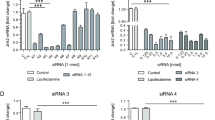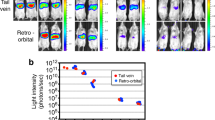Abstract
Hepatocellular carcinoma develops in cirrhotic liver. The nitric oxide (NO) synthase type III (NOS-3) overexpression induces cell death in hepatoblastoma cells. The study developed gene therapy designed to specifically overexpress NOS-3 in cultured hepatoma cells, and in tumors derived from orthotopically implanted tumor cells in fibrotic livers. Liver fibrosis was induced by CCl4 administration in mice. The first-generation adenoviruses were designed to overexpress NOS-3 or green fluorescent protein, and luciferase complementary DNA under the regulation of murine alpha-fetoprotein (AFP) and Rous Sarcoma Virus (RSV) promoters, respectively. Both adenovirus and Hepa 1–6 cells were used for in vitro and in vivo experiments. Adenoviruses were administered through the tail vein 2 weeks after orthotopic tumor cell implantation. AFP-NOS-3/RSV-luciferase increased oxidative-related DNA damage, p53, CD95/CD95L expression and caspase-8, -9 and -3 activities in cultured Hepa 1–6 cells. The increased expression of CD95/CD95L and caspase-8 activity was abolished by Nω-nitro-l-arginine methyl ester hydrochloride, p53 and CD95 small interfering RNA. AFP-NOS-3/RSV-luciferase adenovirus increased cell death markers, and reduced cell proliferation of established tumors in fibrotic livers. The increase of oxidative/nitrosative stress induced by NOS-3 overexpression induced DNA damage, p53, CD95/CD95L expression and cell death in hepatocellular carcinoma cells. The effectiveness of the gene therapy has been demonstrated in vitro and in vivo.
This is a preview of subscription content, access via your institution
Access options
Subscribe to this journal
Receive 12 print issues and online access
$259.00 per year
only $21.58 per issue
Buy this article
- Purchase on Springer Link
- Instant access to full article PDF
Prices may be subject to local taxes which are calculated during checkout






Similar content being viewed by others
Change history
28 March 2023
A Correction to this paper has been published: https://doi.org/10.1038/s41434-023-00397-y
References
Lancaster JR Jr . A tutorial on the diffusibility and reactivity of free nitric oxide. Nitric Oxide 1997; 1: 18–30.
Alderton WK, Cooper CE, Knowles RG . Nitric oxide synthases: structure, function and inhibition. Biochem J 2001; 357: 593–615.
Burke AJ, Sullivan FJ, Giles FJ, Glynn SA . The yin and yang of nitric oxide in cancer progression. Carcinogenesis 2013; 34: 503–512.
Muntane J, la Mata MD . Nitric oxide and cancer. World J Hepatol 2010; 2: 337–344.
McCarthy HO, Coulter JA, Robson T, Hirst DG . Gene therapy via inducible nitric oxide synthase: a tool for the treatment of a diverse range of pathological conditions. J Pharm Pharmacol 2008; 60: 999–1017.
Muntane J, De la Rosa AJ, Marin LM, Padillo FJ . Nitric oxide and cell death in liver cancer cells. Mitochondrion 2013; 13: 257–262.
Aguilar-Melero P, Ferrin G, Muntane J . Effects of nitric oxide synthase-3 overexpression on post-translational modifications and cell survival in HepG2 cells. J Proteomics 2012; 75: 740–755.
Bian K, Murad F . What is next in nitric oxide research? From cardiovascular system to cancer biology. Nitric Oxide 2014; 43: 3–7.
Hirst D, Robson T . Targeting nitric oxide for cancer therapy. J Pharm Pharmacol 2007; 59: 3–13.
Li CQ, Wogan GN . Nitric oxide as a modulator of apoptosis. Cancer Lett 2005; 226: 1–15.
Vieira H, Kroemer G . Mitochondria as targets of apoptosis regulation by nitric oxide. IUBMB Life 2003; 55: 613–616.
Siendones E, Fouad D, Abou-Elella AM, Quintero A, Barrera P, Muntane J . Role of nitric oxide in D-galactosamine-induced cell death and its protection by PGE1 in cultured hepatocytes. Nitric Oxide 2003; 8: 133–143.
Yasuda H, Nakayama K, Watanabe M, Suzuki S, Fuji H, Okinaga S et al. Nitroglycerin treatment may enhance chemosensitivity to docetaxel and carboplatin in patients with lung adenocarcinoma. Clin Cancer Res 2006; 12: 6748–6757.
Siemens DR, Heaton JP, Adams MA, Kawakami J, Graham CH . Phase II study of nitric oxide donor for men with increasing prostate-specific antigen level after surgery or radiotherapy for prostate cancer. Urology 2009; 74: 878–883.
Takabuchi S, Hirota K, Nishi K, Oda S, Oda T, Shingu K et al. The inhibitory effect of sodium nitroprusside on HIF-1 activation is not dependent on nitric oxide-soluble guanylyl cyclase pathway. Biochem Biophys Res Commun 2004; 324: 417–423.
Bonavida B, Baritaki S, Huerta-Yepez S, Vega MI, Chatterjee D, Yeung K . Novel therapeutic applications of nitric oxide donors in cancer: roles in chemo- and immunosensitization to apoptosis and inhibition of metastases. Nitric Oxide 2008; 19: 152–157.
Siendones E, Fouad D, Diaz-Guerra MJ, de la Mata M, Bosca L, Muntane J, PGE1-induced NO . reduces apoptosis by D-galactosamine through attenuation of NF-kappaB and NOS-2 expression in rat hepatocytes. Hepatology 2004; 40: 1295–1303.
Tong L, Wu S . The role of constitutive nitric-oxide synthase in ultraviolet B light-induced nuclear factor kappaB activity. J Biol Chem 2014; 289: 26658–26668.
Fleming I, Busse R . Molecular mechanisms involved in the regulation of the endothelial nitric oxide synthase. Am J Physiol Regul Integr Comp Physiol 2003; 284: R1–12.
Akazawa Y, Gores GJ . Death receptor-mediated liver injury. Semin Liver Dis 2007; 27: 327–338.
Seitz SJ, Schleithoff ES, Koch A, Schuster A, Teufel A, Staib F et al. Chemotherapy-induced apoptosis in hepatocellular carcinoma involves the p53 family and is mediated via the extrinsic and the intrinsic pathway. Int J Cancer 2010; 126: 2049–2066.
Razani B, Woodman SE, Lisanti MP . Caveolae: from cell biology to animal physiology. Pharmacol Rev 2002; 54: 431–467.
Leon-Bollotte L, Subramaniam S, Cauvard O, Plenchette-Colas S, Paul C, Godard C et al. S-nitrosylation of the death receptor fas promotes fas ligand-mediated apoptosis in cancer cells. Gastroenterology 2011; 140: 2009–2018; 2018 e1-4.
Jeong WI, Park O, Radaeva S, Gao B . STAT1 inhibits liver fibrosis in mice by inhibiting stellate cell proliferation and stimulating NK cell cytotoxicity. Hepatology 2006; 44: 1441–1451.
Palanisamy AP, Cheng G, Sutter AG, Liu J, Lewin DN, Chao J et al. Adenovirus-mediated eNOS expression augments liver injury after ischemia/reperfusion in mice. PLoS One 2014; 9: e93304.
Matei V, Rodriguez-Vilarrupla A, Deulofeu R, Colomer D, Fernandez M, Bosch J et al. The eNOS cofactor tetrahydrobiopterin improves endothelial dysfunction in livers of rats with CCl4 cirrhosis. Hepatology 2006; 44: 44–52.
Mookerjee RP, Mehta G, Balasubramaniyan V, Mohamed Fel Z, Davies N, Sharma V et al. Hepatic dimethylarginine-dimethylaminohydrolase1 is reduced in cirrhosis and is a target for therapy in portal hypertension. J Hepatol 2015; 62: 325–331.
Marra M, Sordelli IM, Lombardi A, Lamberti M, Tarantino L, Giudice A et al. Molecular targets and oxidative stress biomarkers in hepatocellular carcinoma: an overview. J Transl Med 2011; 9: 171.
Higaki K, Yano H, Kojiro M . Fas antigen expression and its relationship with apoptosis in human hepatocellular carcinoma and noncancerous tissues. Am J Pathol 1996; 149: 429–437.
Lee SH, Shin MS, Lee HS, Bae JH, Lee HK, Kim HS et al. Expression of Fas and Fas-related molecules in human hepatocellular carcinoma. Hum Pathol 2001; 32: 250–256.
Nakamura M, Nagano H, Sakon M, Yamamoto T, Ota H, Wada H et al. Role of the Fas/FasL pathway in combination therapy with interferon-alpha and fluorouracil against hepatocellular carcinoma in vitro. J Hepatol 2007; 46: 77–88.
Hayden MA, Lange PA, Nakayama DK . Nitric oxide and cyclic guanosine monophosphate stimulate apoptosis via activation of the Fas-FasL pathway. J Surg Res 2001; 101: 183–189.
Martin LJ, Chen K, Liu Z . Adult motor neuron apoptosis is mediated by nitric oxide and Fas death receptor linked by DNA damage and p53 activation. J Neurosci 2005; 25: 6449–6459.
Gonzalez R, Ferrin G, Aguilar-Melero P, Ranchal I, Linares CI, Bello RI et al. Targeting hepatoma using nitric oxide donor strategies. Antioxid Redox Signal 2013; 18: 491–506.
Xu W, Liu L, Charles IG . Microencapsulated iNOS-expressing cells cause tumor suppression in mice. FASEB J 2002; 16: 213–215.
Ambs S, Merriam WG, Ogunfusika MO, Bennett WP, Ishibe N, Hussain SP et al. p53 and vascular endothelial growth factor regulate tumor growth of NOS2-expressing human carcinoma cells. Nat Med 1998; 4: 1371–1376.
Zhang J, Dawson VL, Dawson TM, Snyder SH . Nitric oxide activation of poly(ADP-ribose) synthetase in neurotoxicity. Science 1994; 263: 687–689.
Pande K, Ueda R, Machemer T, Sathe M, Tsai V, Brin E et al. Cancer-induced expansion and activation of CD11b+ Gr-1+ cells predispose mice to adenoviral-triggered anaphylactoid-type reactions. Mol Ther 2009; 17: 508–515.
Gonin S, Diaz-Latoud C, Richard MJ, Ursini MV, Imbo A, Manero F et al. p53/T-antigen complex disruption in T-antigen transformed NIH3T3 fibroblasts exposed to oxidative stress: correlation with the appearance of a Fas/APO-1/CD95 dependent, caspase independent, necrotic pathway. Oncogene 1999; 18: 8011–8023.
Minana JB, Gomez-Cambronero L, Lloret A, Pallardo FV, Del Olmo J, Escudero A et al. Mitochondrial oxidative stress and CD95 ligand: a dual mechanism for hepatocyte apoptosis in chronic alcoholism. Hepatology 2002; 35: 1205–1214.
Reinehr R, Haussinger D . CD95 activation in the liver: ion fluxes and oxidative signaling. Arch Biochem Biophys 2007; 462: 124–131.
Green LC, Wagner DA, Glogowski J, Skipper PL, Wishnok JS, Tannenbaum SR . Analysis of nitrate, nitrite, and [15 N]nitrate in biological fluids. Anal Biochem 1982; 126: 131–138.
Jaffrey SR, Snyder SH . The biotin switch method for the detection of S-nitrosylated proteins. Sci STKE 2001; 2001: pl1.
Acknowledgements
We thank Marcin Balcerzyk, Laura Fernández, Ángel Parrado and Isabel Fernández for their assistance in the PET/CT analysis ('Centro Nacional de Aceleradores' or CNA, Seville, Spain). This study was supported by the Instituto de Salud Carlos III (PS09/00185). CIBERehd was funded by the Instituto de Salud Carlos III.
Author information
Authors and Affiliations
Corresponding author
Ethics declarations
Competing interests
The authors declare no conflict of interest.
Additional information
The original online version of this article was revised: In this article the wrong figure appeared as Fig. 5C.
Rights and permissions
About this article
Cite this article
De la Rosa, Á., Rodríguez-Hernández, Á., González, R. et al. Antitumoral gene-based strategy involving nitric oxide synthase type III overexpression in hepatocellular carcinoma. Gene Ther 23, 67–77 (2016). https://doi.org/10.1038/gt.2015.79
Received:
Revised:
Accepted:
Published:
Issue Date:
DOI: https://doi.org/10.1038/gt.2015.79



